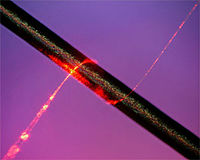Subwavelength-diameter optical fiber

Imagine you have a straw for drinking. It has a very small diameter so you can suck up a liquid without spilling it all over your face. Now imagine the straw is made of glass and it can carry light instead of drinks. The subwavelength-diameter optical fiber is that glass straw, but much thinner and able to carry light that is smaller than its diameter.
But how does the light get through the straw even though it's smaller than the straw itself? Well, the straw is made of a special glass that allows the light to travel through it in a unique way. It bounces off the sides of the straw, kind of like a game of pool, and doesn't get absorbed or lost. This is because the glass is designed to trap the light and not let it escape.
These subwavelength-diameter optical fibers are used in things like medical equipment to see inside the body or to make better internet connections. They're really cool and useful because they can carry light where it needs to go without losing it along the way.
But how does the light get through the straw even though it's smaller than the straw itself? Well, the straw is made of a special glass that allows the light to travel through it in a unique way. It bounces off the sides of the straw, kind of like a game of pool, and doesn't get absorbed or lost. This is because the glass is designed to trap the light and not let it escape.
These subwavelength-diameter optical fibers are used in things like medical equipment to see inside the body or to make better internet connections. They're really cool and useful because they can carry light where it needs to go without losing it along the way.
Related topics others have asked about:
